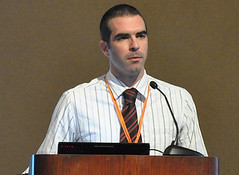 Light intensity affects pupil diameter: the pupil contracts in bright environments and it dilates in the dark. Interestingly, cognitive load also affects pupil diameter, with the pupil dilating in response to increased cognitive load. This effect is called the task evoked pupillary response (TEPR) [1]. Thus, changes in pupil diameter are physiological measures of cognitive load; however changes in lighting introduce noise into the estimate.
Light intensity affects pupil diameter: the pupil contracts in bright environments and it dilates in the dark. Interestingly, cognitive load also affects pupil diameter, with the pupil dilating in response to increased cognitive load. This effect is called the task evoked pupillary response (TEPR) [1]. Thus, changes in pupil diameter are physiological measures of cognitive load; however changes in lighting introduce noise into the estimate.
Last week Oskar Palinko gave a talk at Driving Assessment 2011 introducing our work on disambiguating the effects of cognitive load and light on pupil diameter in driving simulator studies [2]. We hypothesized that we can simply subtract the effect of lighting on pupil diameter from the combined effect of light and cognitive load and produce an estimate of cognitive load only. We tested the hypothesis through an experiment in which participants were given three tasks:
- Cognitive task with varying cognitive load and constant lighting. This task was adapted from the work of Klingner et al. [3]. Participants listened to a voice counting from 1 to 18 repeatedly. Participants were told that every sixth number (6, 12, and 18) might be out of order and were instructed to push a button if they detected an out-of-order number. This task induced increased cognitive load at every sixth number as participants focused on the counting sequence. A new number was read every 1.5 seconds, thus cognitive load (and pupil diameter) increased every 6 x 1.5 sec = 9 seconds.
- Visual task with constant cognitive load (assuming no daydreaming!) and varying lighting. Participants were instructed to follow a visual target which switched location between a white, a gray and a black truck. The light reaching the participant’s eye varied as the participant’s gaze moved from one truck to another. Participants held their gaze on a truck for 9 seconds, allowing the pupil diameter ample time to settle.
- Combined task with varying cognitive load and lighting. Participants completed the cognitive and visual tasks in parallel. We synchronized the cognitive and visual tasks such that increases in cognitive load occurred after the pupil diameter stabilized in response to moving the gaze between trucks. Synchronization was straightforward as the cognitive task was periodic with 9 seconds and in the visual task lighting intensity also changed every 9 seconds.
Our results confirm that, at least in this simple case, our hypothesis holds and we can indeed detect changes in cognitive load under varying lighting conditions. We are planning to extend this work by introducing scenarios in which participants drive in realistic simulated environments. Under such scenarios gaze angles, and thus the amount of light reaching participants’ eyes, will change rapidly, making the disambiguation more complex, and of course more useful.
References
[1] Jackson Beatty, “Task-Evoked Pupillary Responses, Processing Load, and the Structure of Processing Resources,” Psychological Bulletin, 276-292, 91(2)
[2] Oskar Palinko, Andrew L. Kun, “Exploring the Influence of Light and Cognitive Load on Pupil Diameter in Driving Simulator Studies,” Driving Assessment 2011
[3] Jeff Klingner, Rashit Kumar, Pat Hanrahan, “Measuring the Task-Evoked Pupillary Response with a Remote Eye Tracker,” ETRA 2008


